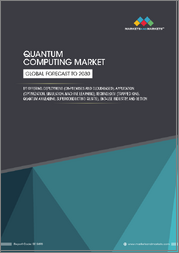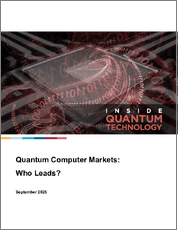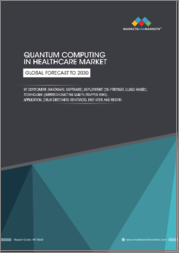
|
시장보고서
상품코드
1595676
의료 분야 양자 컴퓨팅 시장 : 제품, 기술, 배포, 응용 분야, 최종 사용자별 - 세계 예측(2025-2030년)Quantum Computing in Healthcare Market by Offering (Hardware, Services, Software), Technology (Quantum Annealing, Superconducting Qubits, Topological and Photonic), Deployment, Application, End-user - Global Forecast 2025-2030 |
||||||
의료 분야 양자 컴퓨팅 시장은 2023년에 1억 6,776만 달러로 평가되었습니다. 2024년에는 2억 3,735만 달러에 이를 것으로 예측되며, CAGR 42.52%로 성장하여 2030년에는 20억 372만 달러에 달할 전망입니다.
양자컴퓨팅은 데이터 처리, 신약 개발, 유전체학, 개인 맞춤형 의료에 혁명을 가져올 혁신적인 기술 발전입니다. 양자컴퓨팅은 기존 컴퓨터의 능력을 훨씬 뛰어넘는 복잡한 데이터 세트를 처리할 수 있으며, 전례 없는 속도와 정확성을 제공할 수 있습니다. 의료 분야에서 양자 컴퓨팅의 필요성은 급증하는 의료 데이터의 양과 단백질 폴딩, 개인 맞춤형 치료 계획, 유전체 분석과 같이 뛰어난 컴퓨팅 성능을 필요로 하는 문제의 복잡성에서 기인합니다. 주요 응용 분야로는 이미지 처리 속도 향상을 통한 영상 진단 강화, 복잡한 분자 모델링을 통한 신약 개발, 강력한 데이터 분석을 통한 개인 맞춤형 의료 등이 있습니다. 제약회사, 연구기관, 의료 서비스 제공업체 등 다양한 최종 사용처가 양자 기능을 활용하여 효율성과 성과를 높이고자 노력하고 있습니다.
| 주요 시장 통계 | |
|---|---|
| 기준 연도(2023년) | 1억 6,776만 달러 |
| 예측 연도(2024년) | 2억 3,735만 달러 |
| 예측 연도(2030년) | 20억 372만 달러 |
| CAGR(%) | 42.52% |
시장 인사이트에 따르면, 의료 분야 양자 컴퓨팅 시장은 양자 알고리즘의 발전, 하이테크 기업과 의료 서비스 제공업체 간의 협력 증가에 힘입어 성장세를 보이고 있습니다. 또한, 투자 및 정부 지원 증가는 성장 전망을 높이고 있습니다. 그러나 높은 초기 비용, 기술적 장벽, 초기 단계의 양자 기술 등이 시장 확대에 큰 걸림돌로 작용하고 있습니다. 사업 기회는 정밀의료 트렌드와 신약개발 프로세스 가속화에 대한 수요 증가에 있습니다. 이러한 기회를 포착하기 위해 이해관계자들은 양자 인프라에 대한 투자, 지식 교환을 위한 협력 관계 촉진, 상호운용성 문제를 해결하기 위한 표준화 개발에 집중해야 합니다.
연구 개발은 오류 수정, 양자 비트의 안정성 향상, 사용하기 쉬운 양자 소프트웨어 플랫폼 개발 등에 집중해야 합니다. 이러한 부문은 운영 효율을 높이고 비용을 절감하여 큰 수익을 기대할 수 있습니다. 시장의 특성은 역동적이면서도 발전하는 시장이며, 빠른 기술 발전과 경쟁 구도이 특징입니다. 따라서 기업은 연구개발을 우선시하고, 파트너십 구축에 중점을 둔 유연한 전략을 채택하여 선제적으로 대응해야 합니다. 규제 프레임워크에 적극적으로 대처하고 인재 육성에 투자하는 것은 의료의 성장을 가속하고 새로운 양자 기술을 활용하기 위한 필수적인 단계입니다.
시장 역학: 빠르게 진화하는 의료 분야 양자 컴퓨팅 시장의 주요 시장 인사이트을 공개합니다.
의료 분야 양자컴퓨팅 시장은 수요 및 공급의 역동적인 상호작용을 통해 변화하고 있습니다. 이러한 시장 역학의 변화를 이해함으로써 기업은 정보에 입각한 투자 결정을 내리고, 전략적인 의사결정을 정교화하며, 새로운 비즈니스 기회를 포착할 수 있습니다. 이러한 트렌드를 종합적으로 파악함으로써 기업은 정치적, 지리적, 기술적, 사회적, 경제적 영역 전반에 걸친 다양한 리스크를 줄일 수 있으며, 소비자 행동과 그것이 제조 비용 및 구매 동향에 미치는 영향을 보다 명확하게 이해할 수 있습니다.
- 시장 성장 촉진요인
- 의료 분야의 데이터 처리 속도와 효율성, 안전한 데이터 전송 및 통신의 필요성
- 정밀의료 분야에서의 양자컴퓨팅 도입
- 의료 연구 및 신약 개발의 역할 증대
- 시장 성장 억제요인
- 양자컴퓨팅의 정확성에 대한 우려
- 시장 기회
- 양자컴퓨팅 기술의 의료 분야에서의 진보
- 양자 컴퓨팅 스타트업에 대한 적극적인 투자 시나리오
- 시장 과제
- 양자 컴퓨팅에 대한 숙련된 인력 및 전문 지식의 부족
Porter's Five Forces: 의료 분야 양자 컴퓨팅 시장 공략을 위한 전략적 도구
Porter's Five Forces 프레임워크는 시장 상황경쟁 구도를 파악하는 중요한 도구입니다. Porter의 Five Forces 프레임워크는 기업의 경쟁을 평가하고 전략적 기회를 모색하기 위한 명확한 방법을 설명합니다. 이 프레임워크는 기업이 시장 내 세력도를 평가하고 신규 사업의 수익성을 판단하는 데 도움이 됩니다. 이러한 통찰력을 통해 기업은 강점을 활용하고 약점을 보완하며 잠재적 도전을 피함으로써 보다 강력한 시장 포지셔닝을 확보할 수 있습니다.
PESTLE 분석 : 의료 분야 양자컴퓨팅 시장에서의 외부 영향 파악
외부 거시 환경 요인은 의료 분야 양자 컴퓨팅 시장의 성과 역학을 형성하는 데 있어 매우 중요한 역할을 합니다. 정치적, 경제적, 사회적, 기술적, 법적, 환경적 요인에 대한 분석은 이러한 영향을 탐색하는 데 필요한 정보를 담고 있으며, PESTLE 요인을 조사함으로써 기업은 잠재적인 위험과 기회를 더 잘 이해할 수 있습니다. 이러한 분석을 통해 기업은 규제, 소비자 선호도, 경제 동향의 변화를 예측하고 선제적이고 적극적인 의사결정을 내릴 준비를 할 수 있습니다.
시장 점유율 분석 : 의료용 양자컴퓨팅 시장에서경쟁 구도 파악
의료 분야 양자 컴퓨팅 시장의 상세한 시장 점유율 분석을 통해 벤더의 성과를 종합적으로 평가할 수 있습니다. 기업은 수익, 고객 기반, 성장률 등 주요 지표를 비교하여 경쟁적 위치를 파악할 수 있습니다. 이 분석은 시장의 집중화, 세분화 및 통합 추세를 파악하여 공급업체가 치열한 경쟁에서 자신의 입지를 강화할 수 있는 전략적 의사결정을 내리는 데 필요한 통찰력을 제공합니다.
FPNV 포지셔닝 매트릭스: 의료용 양자컴퓨팅 시장에서의 벤더 성능 평가
FPNV 포지셔닝 매트릭스는 의료용 양자 컴퓨팅 시장에서 벤더를 평가하는 중요한 도구입니다. 이 매트릭스를 통해 비즈니스 조직은 벤더의 비즈니스 전략과 제품 만족도를 기반으로 벤더를 평가하여 목표에 부합하는 정보에 입각한 의사결정을 내릴 수 있으며, 4개의 사분면으로 벤더를 명확하고 정확하게 세분화하여 전략 목표에 가장 적합한 파트너와 솔루션을 식별할 수 있습니다. 전략 목표에 가장 적합한 파트너와 솔루션을 식별할 수 있습니다.
전략 분석 및 추천: 의료 분야 양자 컴퓨팅 시장에서 성공의 길을 그립니다.
의료 분야 양자컴퓨팅 시장의 전략적 분석은 세계 시장에서의 입지를 강화하고자 하는 기업에게 필수적입니다. 주요 자원, 역량 및 성과 지표를 검토함으로써 기업은 성장 기회를 식별하고 개선할 수 있습니다. 이러한 접근 방식을 통해 경쟁 환경의 도전을 극복하고 새로운 비즈니스 기회를 활용하여 장기적인 성공을 달성할 수 있도록 준비할 수 있습니다.
이 보고서는 주요 관심 부문에 대한 종합적인 시장 분석을 제공합니다.
1. 시장 침투도 : 현재 시장 환경의 상세한 검토, 주요 기업의 광범위한 데이터, 시장 도달 범위 및 전반적인 영향력을 평가합니다.
2. 시장 개척도: 신흥 시장에서의 성장 기회를 파악하고, 기존 부문의 확장 가능성을 평가하며, 미래 성장을 위한 전략적 로드맵을 기술하고 있습니다.
3. 시장 다각화 : 최근 제품 출시, 미개척 지역, 산업의 주요 발전, 시장을 형성하는 전략적 투자를 분석합니다.
4. 경쟁 평가 및 정보 : 경쟁 구도를 철저히 분석하여 시장 점유율, 사업 전략, 제품 포트폴리오, 인증, 규제 당국의 승인, 특허 동향, 주요 기업의 기술 발전 등을 검토합니다.
5. 제품 개발 및 혁신 : 미래 시장 성장을 가속할 것으로 예상되는 첨단 기술, 연구 개발 활동 및 제품 혁신을 강조합니다.
또한, 이해관계자들이 충분한 정보를 바탕으로 의사결정을 내릴 수 있도록 중요한 질문에 대한 답변도 제공합니다.
1. 현재 시장 규모와 향후 성장 전망은?
2. 최고의 투자 기회를 제공하는 제품, 지역은?
3. 시장을 형성하는 주요 기술 동향과 규제의 영향은?
4. 주요 벤더의 시장 점유율과 경쟁 포지션은?
5.벤더 시장 진입 및 철수 전략의 원동력이 되는 수익원과 전략적 기회는 무엇인가?
목차
제1장 서문
제2장 조사 방법
제3장 주요 요약
제4장 시장 개요
제5장 시장 인사이트
- 시장 역학
- 성장 촉진요인
- 성장 억제요인
- 기회
- 과제
- 시장 세분화 분석
- Porter의 Five Forces 분석
- PESTLE 분석
- 정치
- 경제
- 사회
- 기술
- 법률
- 환경
제6장 의료 분야 양자 컴퓨팅 시장 : 제공 제품별
- 서론
- 하드웨어
- 서비스
- 소프트웨어
제7장 의료 분야 양자 컴퓨팅 시장 : 기술별
- 서론
- 양자 어닐링
- 초전도 양자 비트
- 트포로지칼과 포토닉
- 트랩 이온
제8장 의료 분야 양자 컴퓨팅 시장 : 전개 형태별
- 서론
- 클라우드 기반
- 온프레미스
제9장 의료 분야 양자 컴퓨팅 시장 : 용도별
- 서론
- rug Discovery & development
- 유전체학 및 정밀의료
- 의료 진단
제10장 의료 분야 양자 컴퓨팅 시장 : 최종사용자별
- 서론
- 임상 실험실 및 연구기관
- 의약품 및 바이오의약품
제11장 아메리카의 의료 분야 양자 컴퓨팅 시장
- 서론
- 아르헨티나
- 브라질
- 캐나다
- 멕시코
- 미국
제12장 아시아태평양의 의료 분야 양자 컴퓨팅 시장
- 서론
- 호주
- 중국
- 인도
- 인도네시아
- 일본
- 말레이시아
- 필리핀
- 싱가포르
- 한국
- 대만
- 태국
- 베트남
제13장 유럽, 중동 및 아프리카의 의료 분야 양자 컴퓨팅 시장
- 서론
- 덴마크
- 이집트
- 핀란드
- 프랑스
- 독일
- 이스라엘
- 이탈리아
- 네덜란드
- 나이지리아
- 노르웨이
- 폴란드
- 카타르
- 러시아
- 사우디아라비아
- 남아프리카공화국
- 스페인
- 스웨덴
- 스위스
- 터키
- 아랍에미리트(UAE)
- 영국
제14장 경쟁 구도
- 시장 점유율 분석, 2023년
- FPNV 포지셔닝 매트릭스, 2023년
- 경쟁 시나리오 분석
- 전략 분석과 제안
기업 리스트
- Accenture
- Atos SE
- Classiq Technologies Ltd.
- D-Wave Quantum Inc.
- Fujitsu
- Google LLC by Alphabet Inc.
- ID Quantique
- International Business Machines Corporation
- IonQ, Inc.
- PASQAL
- Protiviti India Member Private Limited
- PwC
- Quantinuum Ltd.
- Rigetti & Co, LLC
- SandboxAQ
- SEEQC
- Xanadu Quantum Technologies Inc.
- Zapata Computing, Inc.
The Quantum Computing in Healthcare Market was valued at USD 167.76 million in 2023, expected to reach USD 237.35 million in 2024, and is projected to grow at a CAGR of 42.52%, to USD 2,003.72 million by 2030.
Quantum computing in healthcare represents a transformative technological advancement poised to revolutionize data processing, drug discovery, genomics, and personalized medicine. Its scope lies in the potential to process complex data sets far beyond the capabilities of classical computers, offering unprecedented speed and accuracy. The necessity of quantum computing in healthcare arises from the burgeoning volume of medical data and the complexity of problems such as protein folding, personalized treatment plans, and genomic analysis that demand superior computational power. Key applications include enhancing imaging diagnostics through faster image processing, drug discovery via complex molecular modeling, and personalized healthcare through robust data analysis. End-use scope spans across pharmaceutical companies, research institutions, and healthcare providers, each seeking to leverage quantum capabilities for enhancing efficiency and outcomes.
| KEY MARKET STATISTICS | |
|---|---|
| Base Year [2023] | USD 167.76 million |
| Estimated Year [2024] | USD 237.35 million |
| Forecast Year [2030] | USD 2,003.72 million |
| CAGR (%) | 42.52% |
Market insights reveal that the quantum computing in healthcare market is driven by advancements in quantum algorithms and increasing collaborations between tech firms and healthcare providers. Additionally, rising investments and governmental support amplify growth prospects. However, challenges such as high initial costs, technical barriers, and the nascent stage of quantum technology pose considerable hurdles to market expansion. Opportunities lie in the growing trend of precision medicine and the demand for accelerated drug discovery processes. To seize these opportunities, stakeholders should invest in quantum infrastructure, foster collaborations for knowledge exchange, and focus on standards development to address interoperability issues.
Innovation and research should target error correction, improving qubit stability, and developing user-friendly quantum software platforms. These areas promise significant returns by enhancing operational efficiency and reducing costs. The nature of the market is dynamic yet nascent, characterized by rapid technological advancements and a competitive landscape. Therefore, businesses should adopt flexible strategies that prioritize research and development and focus on building partnerships to stay ahead. Embracing a proactive approach to regulatory frameworks and investing in workforce training are essential steps to bolster growth and capitalize on emerging quantum technologies in healthcare.
Market Dynamics: Unveiling Key Market Insights in the Rapidly Evolving Quantum Computing in Healthcare Market
The Quantum Computing in Healthcare Market is undergoing transformative changes driven by a dynamic interplay of supply and demand factors. Understanding these evolving market dynamics prepares business organizations to make informed investment decisions, refine strategic decisions, and seize new opportunities. By gaining a comprehensive view of these trends, business organizations can mitigate various risks across political, geographic, technical, social, and economic domains while also gaining a clearer understanding of consumer behavior and its impact on manufacturing costs and purchasing trends.
- Market Drivers
- Need for faster & efficient data operations, secure data transfer, and communications in healthcare
- Adoption of quantum computing in precision medicine
- Increasing role in medical research and drug discovery
- Market Restraints
- Accuracy concerns related to quantum computing
- Market Opportunities
- Advancements in quantum computing technology for medical applications
- Positive investment scenario for quantum computing start-ups
- Market Challenges
- Limited skilled resources and expertise in quantum computing
Porter's Five Forces: A Strategic Tool for Navigating the Quantum Computing in Healthcare Market
Porter's five forces framework is a critical tool for understanding the competitive landscape of the Quantum Computing in Healthcare Market. It offers business organizations with a clear methodology for evaluating their competitive positioning and exploring strategic opportunities. This framework helps businesses assess the power dynamics within the market and determine the profitability of new ventures. With these insights, business organizations can leverage their strengths, address weaknesses, and avoid potential challenges, ensuring a more resilient market positioning.
PESTLE Analysis: Navigating External Influences in the Quantum Computing in Healthcare Market
External macro-environmental factors play a pivotal role in shaping the performance dynamics of the Quantum Computing in Healthcare Market. Political, Economic, Social, Technological, Legal, and Environmental factors analysis provides the necessary information to navigate these influences. By examining PESTLE factors, businesses can better understand potential risks and opportunities. This analysis enables business organizations to anticipate changes in regulations, consumer preferences, and economic trends, ensuring they are prepared to make proactive, forward-thinking decisions.
Market Share Analysis: Understanding the Competitive Landscape in the Quantum Computing in Healthcare Market
A detailed market share analysis in the Quantum Computing in Healthcare Market provides a comprehensive assessment of vendors' performance. Companies can identify their competitive positioning by comparing key metrics, including revenue, customer base, and growth rates. This analysis highlights market concentration, fragmentation, and trends in consolidation, offering vendors the insights required to make strategic decisions that enhance their position in an increasingly competitive landscape.
FPNV Positioning Matrix: Evaluating Vendors' Performance in the Quantum Computing in Healthcare Market
The Forefront, Pathfinder, Niche, Vital (FPNV) Positioning Matrix is a critical tool for evaluating vendors within the Quantum Computing in Healthcare Market. This matrix enables business organizations to make well-informed decisions that align with their goals by assessing vendors based on their business strategy and product satisfaction. The four quadrants provide a clear and precise segmentation of vendors, helping users identify the right partners and solutions that best fit their strategic objectives.
Strategy Analysis & Recommendation: Charting a Path to Success in the Quantum Computing in Healthcare Market
A strategic analysis of the Quantum Computing in Healthcare Market is essential for businesses looking to strengthen their global market presence. By reviewing key resources, capabilities, and performance indicators, business organizations can identify growth opportunities and work toward improvement. This approach helps businesses navigate challenges in the competitive landscape and ensures they are well-positioned to capitalize on newer opportunities and drive long-term success.
Key Company Profiles
The report delves into recent significant developments in the Quantum Computing in Healthcare Market, highlighting leading vendors and their innovative profiles. These include Accenture, Atos SE, Classiq Technologies Ltd., D-Wave Quantum Inc., Fujitsu, Google LLC by Alphabet Inc., ID Quantique, International Business Machines Corporation, IonQ, Inc., PASQAL, Protiviti India Member Private Limited, PwC, Quantinuum Ltd., Rigetti & Co, LLC, SandboxAQ, SEEQC, Xanadu Quantum Technologies Inc., and Zapata Computing, Inc..
Market Segmentation & Coverage
This research report categorizes the Quantum Computing in Healthcare Market to forecast the revenues and analyze trends in each of the following sub-markets:
- Based on Offering, market is studied across Hardware, Services, and Software.
- Based on Technology, market is studied across Quantum Annealing, Superconducting Qubits, Topological and Photonic, and Trapped Ions.
- Based on Deployment, market is studied across Cloud-Based and On-Premise.
- Based on Application, market is studied across Drug Discovery & development, Genomics & Precision Medicine, and Medical Diagnostics.
- Based on End-user, market is studied across Clinical Labs and Research Institutes and Pharmaceutical & Biopharmaceutical.
- Based on Region, market is studied across Americas, Asia-Pacific, and Europe, Middle East & Africa. The Americas is further studied across Argentina, Brazil, Canada, Mexico, and United States. The United States is further studied across California, Florida, Illinois, New York, Ohio, Pennsylvania, and Texas. The Asia-Pacific is further studied across Australia, China, India, Indonesia, Japan, Malaysia, Philippines, Singapore, South Korea, Taiwan, Thailand, and Vietnam. The Europe, Middle East & Africa is further studied across Denmark, Egypt, Finland, France, Germany, Israel, Italy, Netherlands, Nigeria, Norway, Poland, Qatar, Russia, Saudi Arabia, South Africa, Spain, Sweden, Switzerland, Turkey, United Arab Emirates, and United Kingdom.
The report offers a comprehensive analysis of the market, covering key focus areas:
1. Market Penetration: A detailed review of the current market environment, including extensive data from top industry players, evaluating their market reach and overall influence.
2. Market Development: Identifies growth opportunities in emerging markets and assesses expansion potential in established sectors, providing a strategic roadmap for future growth.
3. Market Diversification: Analyzes recent product launches, untapped geographic regions, major industry advancements, and strategic investments reshaping the market.
4. Competitive Assessment & Intelligence: Provides a thorough analysis of the competitive landscape, examining market share, business strategies, product portfolios, certifications, regulatory approvals, patent trends, and technological advancements of key players.
5. Product Development & Innovation: Highlights cutting-edge technologies, R&D activities, and product innovations expected to drive future market growth.
The report also answers critical questions to aid stakeholders in making informed decisions:
1. What is the current market size, and what is the forecasted growth?
2. Which products, segments, and regions offer the best investment opportunities?
3. What are the key technology trends and regulatory influences shaping the market?
4. How do leading vendors rank in terms of market share and competitive positioning?
5. What revenue sources and strategic opportunities drive vendors' market entry or exit strategies?
Table of Contents
1. Preface
- 1.1. Objectives of the Study
- 1.2. Market Segmentation & Coverage
- 1.3. Years Considered for the Study
- 1.4. Currency & Pricing
- 1.5. Language
- 1.6. Stakeholders
2. Research Methodology
- 2.1. Define: Research Objective
- 2.2. Determine: Research Design
- 2.3. Prepare: Research Instrument
- 2.4. Collect: Data Source
- 2.5. Analyze: Data Interpretation
- 2.6. Formulate: Data Verification
- 2.7. Publish: Research Report
- 2.8. Repeat: Report Update
3. Executive Summary
4. Market Overview
5. Market Insights
- 5.1. Market Dynamics
- 5.1.1. Drivers
- 5.1.1.1. Need for faster & efficient data operations, secure data transfer, and
- 5.1.1. Drivers
communications in healthcare
- 5.1.1.2. Adoption of quantum computing in precision medicine
- 5.1.1.3. Increasing role in medical research and drug discovery
- 5.1.2. Restraints
- 5.1.2.1. Accuracy concerns related to quantum computing
- 5.1.3. Opportunities
- 5.1.3.1. Advancements in quantum computing technology for medical applications
- 5.1.3.2. Positive investment scenario for quantum computing start-ups
- 5.1.4. Challenges
- 5.1.4.1. Limited skilled resources and expertise in quantum computing
- 5.2. Market Segmentation Analysis
- 5.3. Porter's Five Forces Analysis
- 5.3.1. Threat of New Entrants
- 5.3.2. Threat of Substitutes
- 5.3.3. Bargaining Power of Customers
- 5.3.4. Bargaining Power of Suppliers
- 5.3.5. Industry Rivalry
- 5.4. PESTLE Analysis
- 5.4.1. Political
- 5.4.2. Economic
- 5.4.3. Social
- 5.4.4. Technological
- 5.4.5. Legal
- 5.4.6. Environmental
6. Quantum Computing in Healthcare Market, by Offering
- 6.1. Introduction
- 6.2. Hardware
- 6.3. Services
- 6.4. Software
7. Quantum Computing in Healthcare Market, by Technology
- 7.1. Introduction
- 7.2. Quantum Annealing
- 7.3. Superconducting Qubits
- 7.4. Topological and Photonic
- 7.5. Trapped Ions
8. Quantum Computing in Healthcare Market, by Deployment
- 8.1. Introduction
- 8.2. Cloud-Based
- 8.3. On-Premise
9. Quantum Computing in Healthcare Market, by Application
- 9.1. Introduction
- 9.2. Drug Discovery & development
- 9.3. Genomics & Precision Medicine
- 9.4. Medical Diagnostics
10. Quantum Computing in Healthcare Market, by End-user
- 10.1. Introduction
- 10.2. Clinical Labs and Research Institutes
- 10.3. Pharmaceutical & Biopharmaceutical
11. Americas Quantum Computing in Healthcare Market
- 11.1. Introduction
- 11.2. Argentina
- 11.3. Brazil
- 11.4. Canada
- 11.5. Mexico
- 11.6. United States
12. Asia-Pacific Quantum Computing in Healthcare Market
- 12.1. Introduction
- 12.2. Australia
- 12.3. China
- 12.4. India
- 12.5. Indonesia
- 12.6. Japan
- 12.7. Malaysia
- 12.8. Philippines
- 12.9. Singapore
- 12.10. South Korea
- 12.11. Taiwan
- 12.12. Thailand
- 12.13. Vietnam
13. Europe, Middle East & Africa Quantum Computing in Healthcare Market
- 13.1. Introduction
- 13.2. Denmark
- 13.3. Egypt
- 13.4. Finland
- 13.5. France
- 13.6. Germany
- 13.7. Israel
- 13.8. Italy
- 13.9. Netherlands
- 13.10. Nigeria
- 13.11. Norway
- 13.12. Poland
- 13.13. Qatar
- 13.14. Russia
- 13.15. Saudi Arabia
- 13.16. South Africa
- 13.17. Spain
- 13.18. Sweden
- 13.19. Switzerland
- 13.20. Turkey
- 13.21. United Arab Emirates
- 13.22. United Kingdom
14. Competitive Landscape
- 14.1. Market Share Analysis, 2023
- 14.2. FPNV Positioning Matrix, 2023
- 14.3. Competitive Scenario Analysis
- 14.4. Strategy Analysis & Recommendation
Companies Mentioned
- 1. Accenture
- 2. Atos SE
- 3. Classiq Technologies Ltd.
- 4. D-Wave Quantum Inc.
- 5. Fujitsu
- 6. Google LLC by Alphabet Inc.
- 7. ID Quantique
- 8. International Business Machines Corporation
- 9. IonQ, Inc.
- 10. PASQAL
- 11. Protiviti India Member Private Limited
- 12. PwC
- 13. Quantinuum Ltd.
- 14. Rigetti & Co, LLC
- 15. SandboxAQ
- 16. SEEQC
- 17. Xanadu Quantum Technologies Inc.
- 18. Zapata Computing, Inc.



















